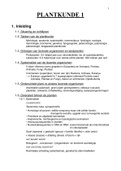Summary
Toegepaste plantkunde: morfologie en diversiteit; samenvatting
- Course
- Institution
Een overzichtelijke samenvatting van het vak Toegepaste plantkunde: morfologie en diversiteit, in het eerste jaar van bio-ingenieur. Gestructureerd op basis van belangrijke kernbegrippen. Als je alle begrippen in de samenvatting kent dan ben je goed voorbereid op het examen.
[Show more]



